Rules in assets management
Rules in the Asset Management section act as automation tools that initiate selected actions in response to specific asset events. Examples of events may include:
Registration of a new asset.
Assigning an organizational structure to a asset.
Elimination of the asset.
Possible actions assigned to rules in the context of Asset Management may include:
Set the status of the asset, for example, as “in storage,” “in use,” or “decommissioned/disposed.”
Assignment of a asset to a specific organizational unit.
These rules enable automation and streamlining of Asset Management processes, resulting in increased efficiency and operational effectiveness of the Asset Management department.
More on assets: Go >
For more on actions: Go >
It is crucial to design rules that are simple and thoughtful, with unambiguous names indicating their function or application. It's also important to describe each rule in detail to make it easy to understand its purpose and operation, which provides transparency and management efficiency, and makes the IT team's job easier.
New rule
To add a new rule, go to Asset Management > Rules, and then click the “New rule” button.
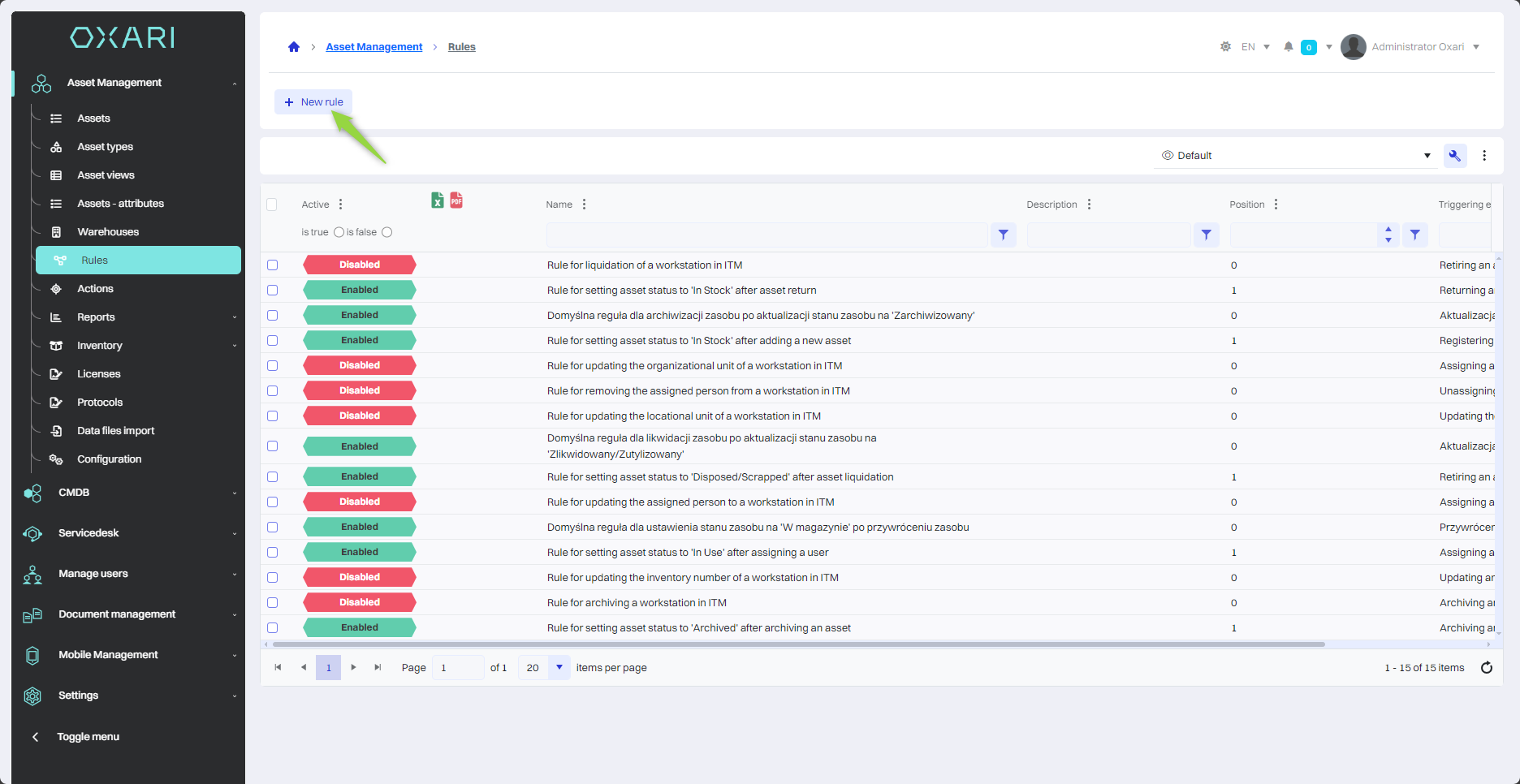
Filling in the rule
Next, in the “New rule definition” window, fill in the desired fields and click the “Save” button.
| 1 | Rule activation - Checking the “Active” option activates the rule. |
| 2 | Name - Used to identify the rule. |
| 3 | Description - Allows you to understand the purpose of the rule. |
| 4 | Trigger event - Select the event that will trigger the rule, for example, “Registration of a new asset” (Optional). |
| 5 | Schedule (tasks) - Specify when the rule is to be active (Optional). More regarding schedules: Go > |
| 6 | Position - Determine the order in which the rules are executed, if there are more rules. |
| 7 | Starting rule - Optional setting of the rule to be the trigger for the current rule. |
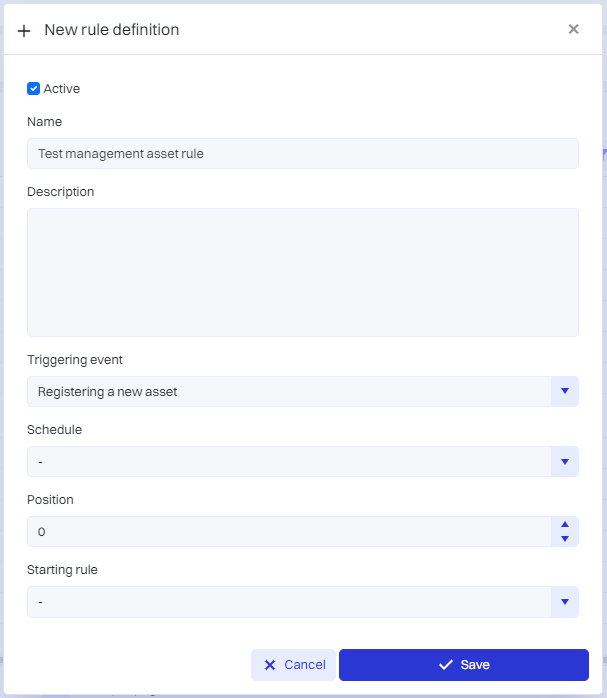
Specifying the action/condition of the rule
After creating a rule, the user will be taken to the rule creation window. Rules in Oxari work on an “if-then” basis, where certain conditions (if) trigger certain actions (this). In this case, the triggering event is “Register new asset.” To assign an action or condition to the event, click on the tile in question.
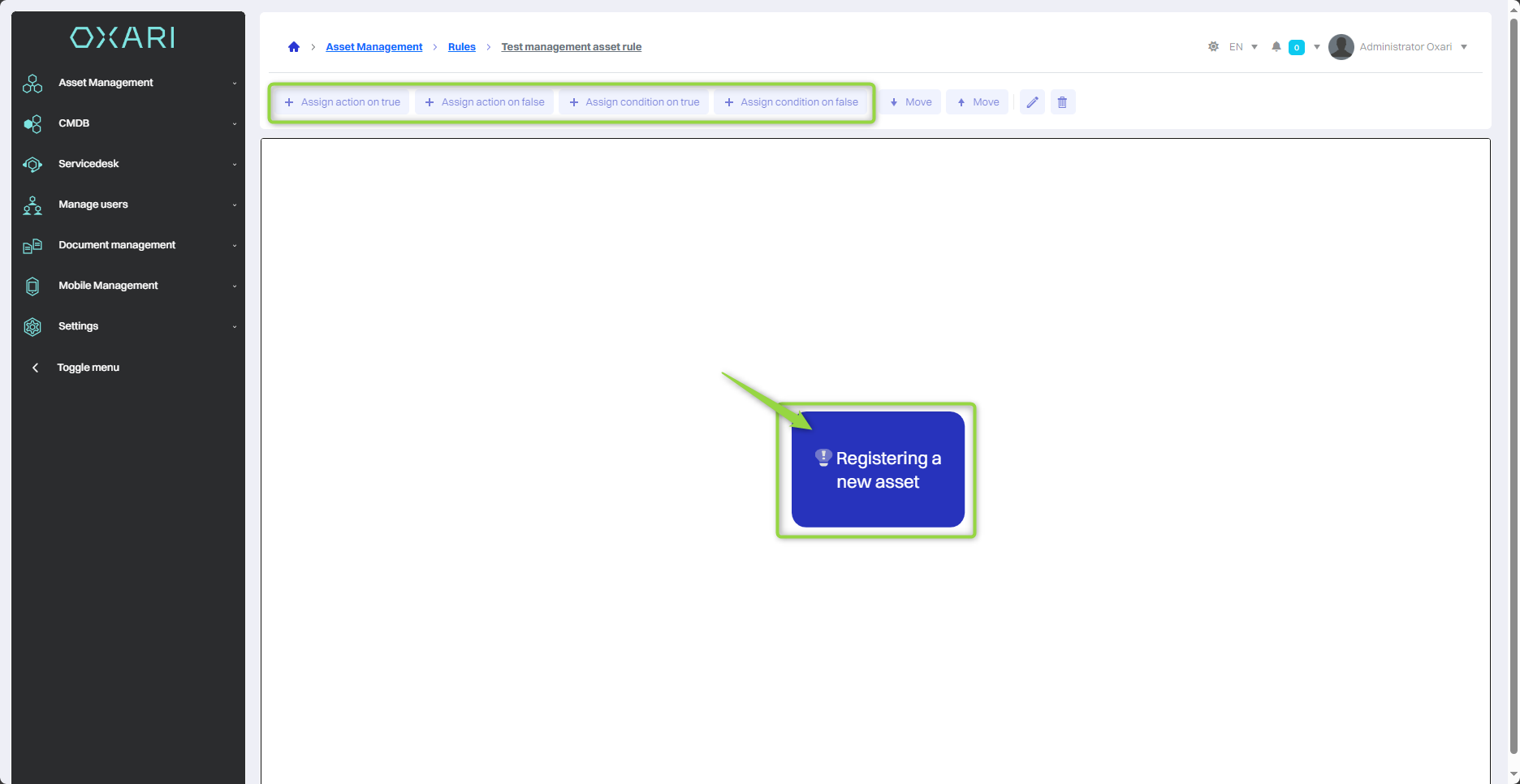
Assigning a condition
After clicking on the tile, two options will be available to use “Assign action for TRUE” and “Assign condition for TRUE”. In this example, a condition will be added first. Click the “Assign condition for TRUE” button.
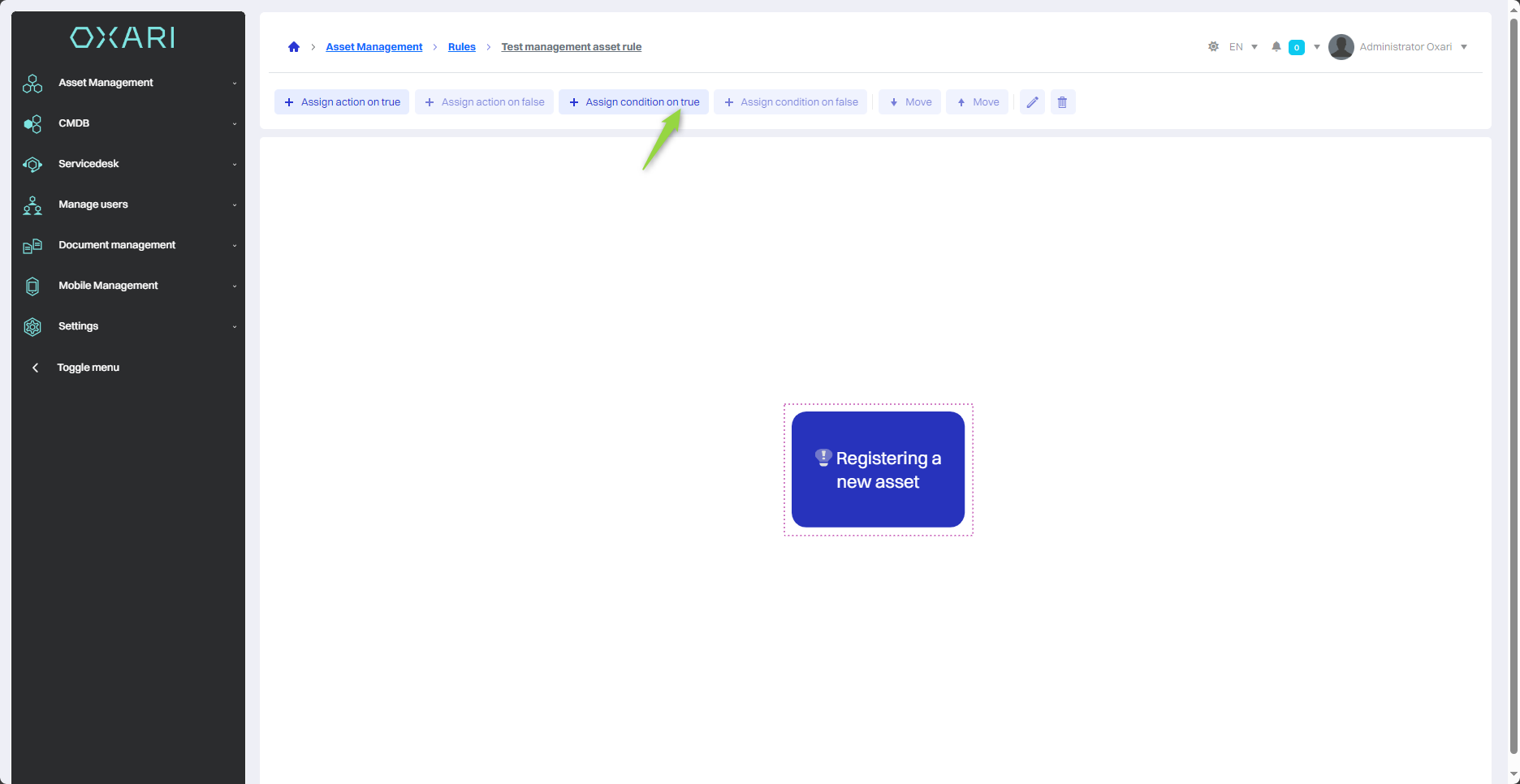
Then, in the “Select condition type” window, the user has a choice of specifying conditions for the newly created rule. In the “New” field, you can select the criterion by which the rule will be applied, for example, “asset type”. The available condition types are:
| 1 | Bit attribute for a asset - Specifies a specific logical value (true/false) assigned to a asset that can activate a rule. |
| 2 | asset provider - Allows you to run a rule based on the provider from which the asset originated. |
| 3 | Model zasobu - Aktywuje regułę w zależności od modelu zasobu. |
| 4 | asset name - A condition based on the name of the asset. |
| 5 | Date difference - Can be used to trigger rules after a certain period of time. |
| 6 | State of the asset - Defines whether the rule is applied according to the state of the asset, such as “in use” or “in stock.” |
| 7 | asset type - A condition related to the type of asset, for example, “computer” or “vehicle”. |
Click the “Save” button to configure the condition.
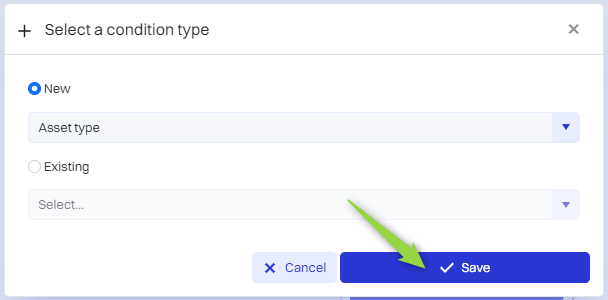
Then in the “New condition” window you will find:
| 1 | Field for entering the name of the new condition. |
| 2 | A drop-down menu with a “contains in” option, so that the condition can be specified on the type of asset. |
| 3 | A field to enter a condition (asset type is contained in Monitor) which means that the condition will work when the asset type is Monitor. |
You should, fill in the fields, and then click the “Save” button.

A given condition has been created and both actions and subsequent conditions can be assigned to it in the Oxari system. These actions and conditions are designated to be executed when the original condition is met (TRUE), as well as to be executed when the condition is not met (FALSE).

Assigning an action
In the example in question, when the condition of the asset type contains monitor is met, to assign an action to it, click on the “Monitor asset type” tile, and then select “Assign action for TRUE”.

In the process of defining rules in the Oxari system, the user, after creating a condition, can proceed to assign an action. There are two options available:
| 1 | “New” - Allows you to create a new action that will be executed when the condition is met. |
| 2 | “Search” - Allows you to select actions that have already been defined in the section Asset Management > Actions. For more on stocks: Go > |
In the example under discussion, a new action is created. To create a new action, the user should select the “New” option and proceed to the process of configuring this action.
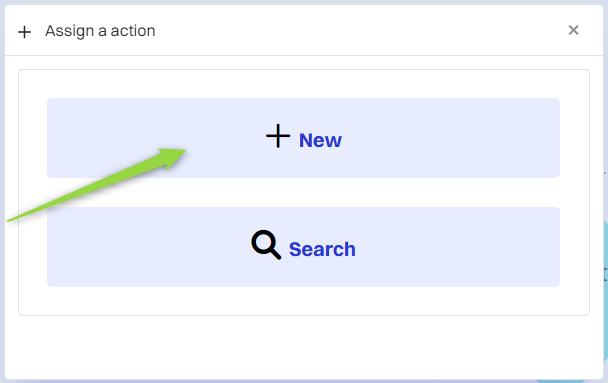
Then, in the “Select Action” window, there are action types to choose from, such as:
| 1 | Set asset status - Allows you to change the status of a asset, such as from “in stock” to “in use.” |
| 2 | Send Email - Enables automatic sending of email notifications in connection with a asset. |
| 3 | Set organizational unit of the asset - Assigns the asset to a specific organizational unit. |
| 4 | Remove the organizational unit of the asset - Disconnects the asset from the assigned organizational unit. |
| 5 | Set the bit attribute value for the asset - Changes the value of the specified binary attribute (yes/no, true/false) of the asset. |
In the example in question, the “Set asset unit” action is assigned, click in the field, and then click the “Select” button.
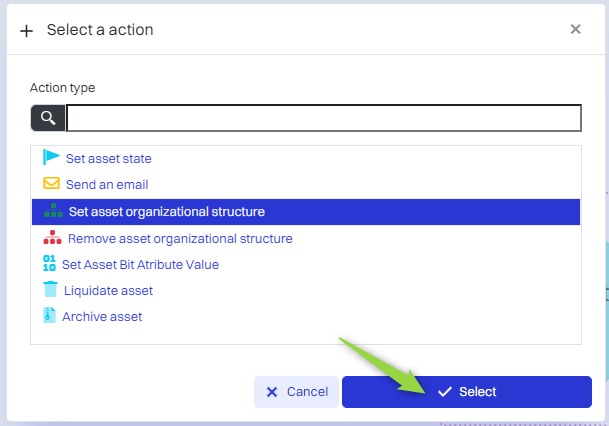
Next, the “Set organizational structure of the asset” window is used to set the organizational structure for the asset.
| 1 | Name - The user can enter the title of the action for easy identification. |
| 2 | Organizational structure - A drop-down menu from which you can select the appropriate organizational unit to which the asset will be assigned. More about the organizations: Go > |
| 3 | User organizational structure - An optional checkbox that, when checked, will automatically assign the asset to the organizational structure of the person currently using the asset. |
Fill in the desired fields and click the “Save” button.

The given action has been added to the rule. It may happen that it is not immediately visible, in which case you need to refresh the page.
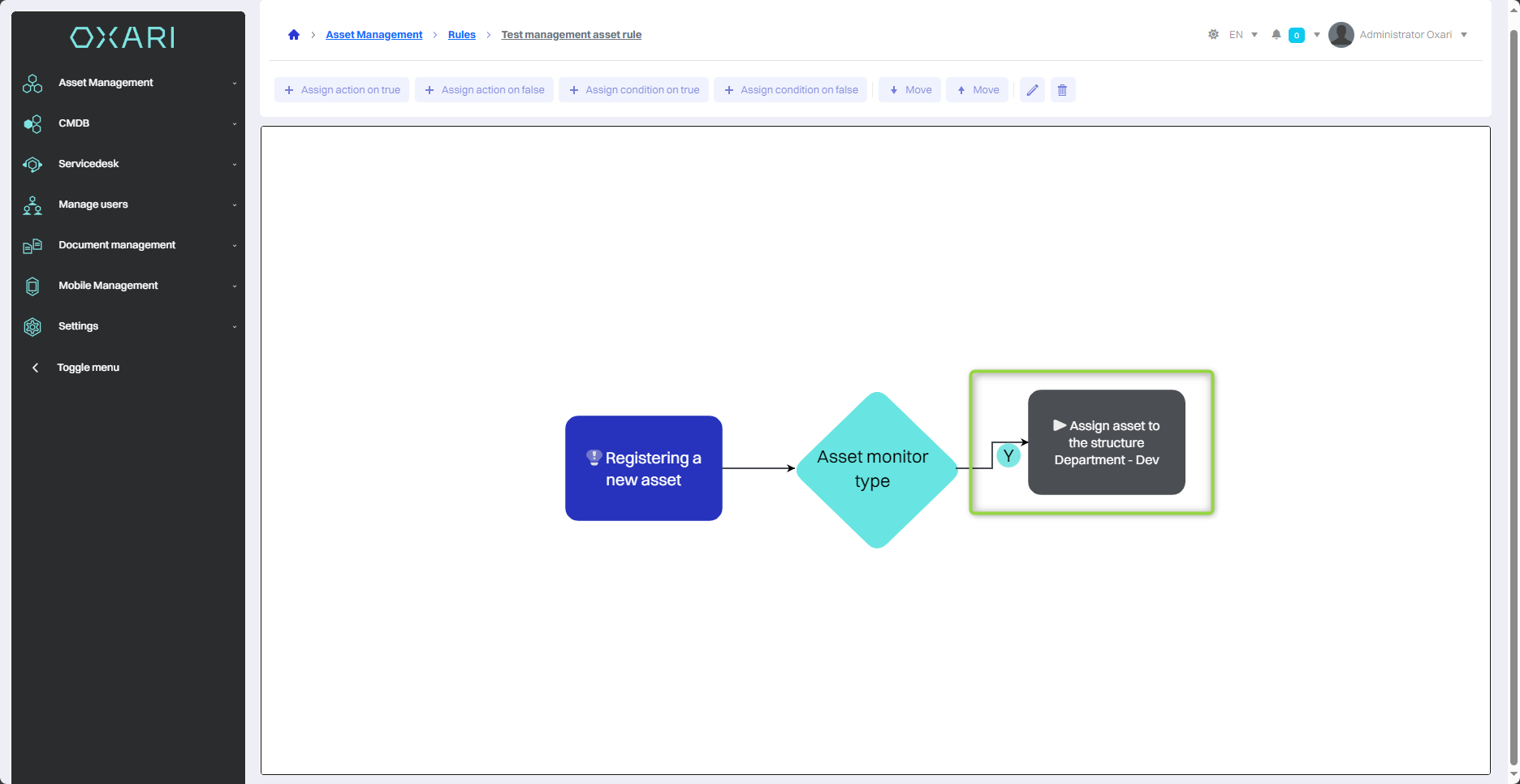
Once a new action is created, it becomes available under Asset Management > Actions and can be reused in various rules. To use an already existing action, in the “Assign Action” window, simply select “Search”, find the desired action in the list and confirm the selection by clicking “Save”. This allows you to effectively use the action in different scenarios without having to create it again.
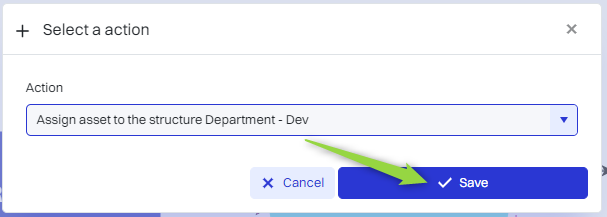
Editing/deleting actions and conditions
To edit or delete actions and conditions, simply go to Asset Management > Rules. Then, to see more options for a rule, click the “Details” button next to the selected rule.
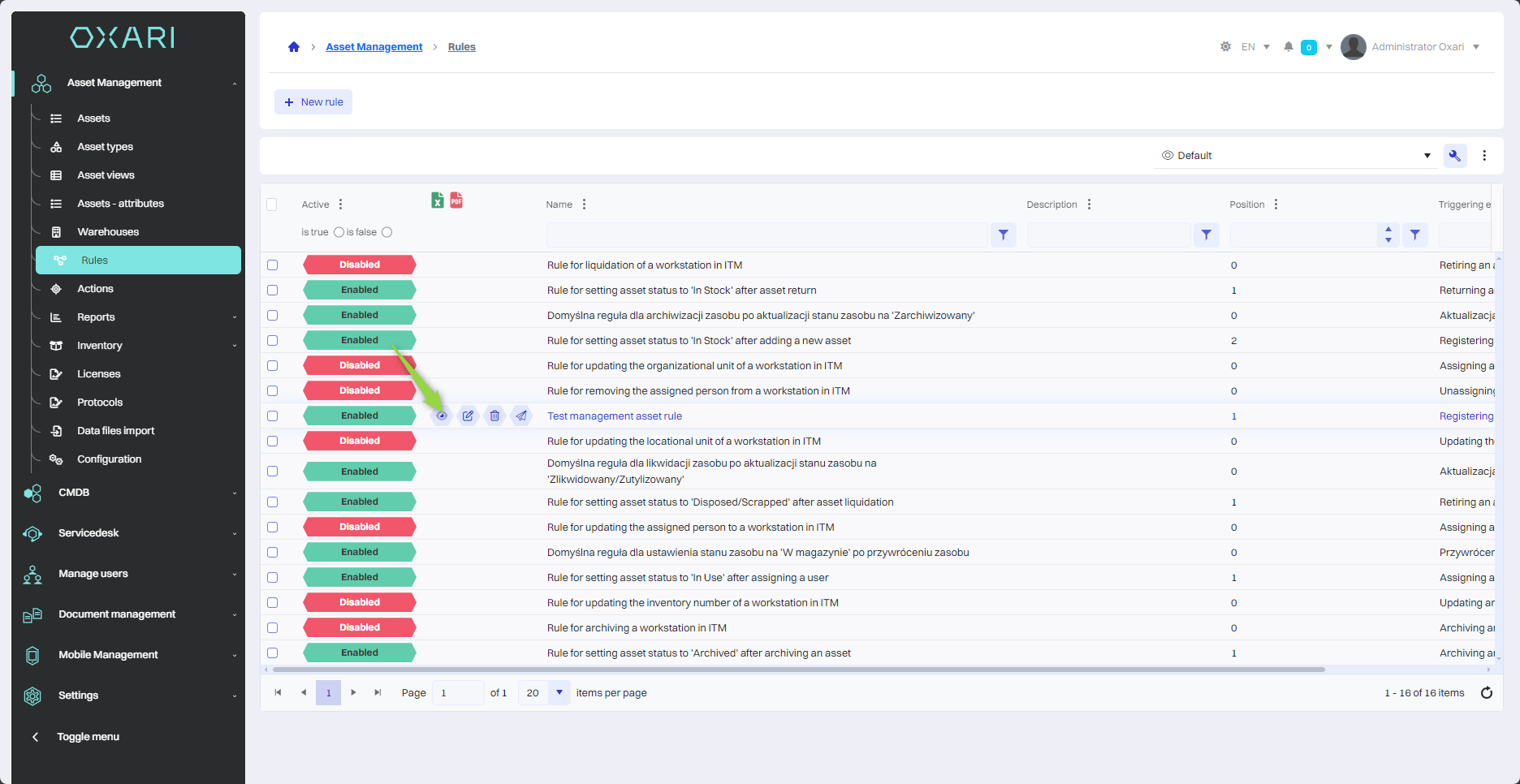
In the rule details, select the desired action/condition by clicking on the tile of the corresponding action/condition. The edit/delete options will be visible in the upper right corner.
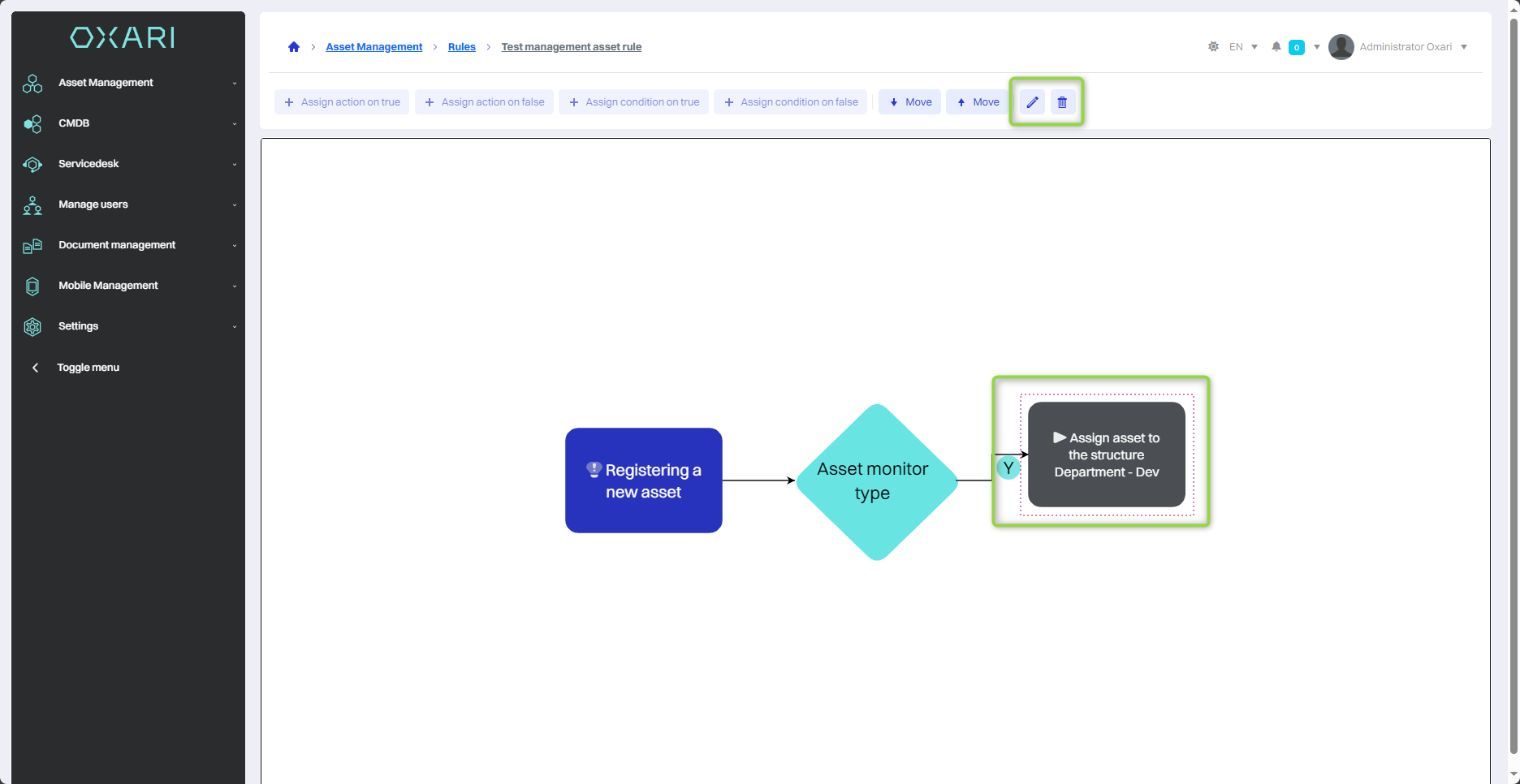
Editing/Deleting a rule
To edit or delete rules, go to Asset Management > Rules. Hover over the desired rule. The edit/delete buttons will appear.
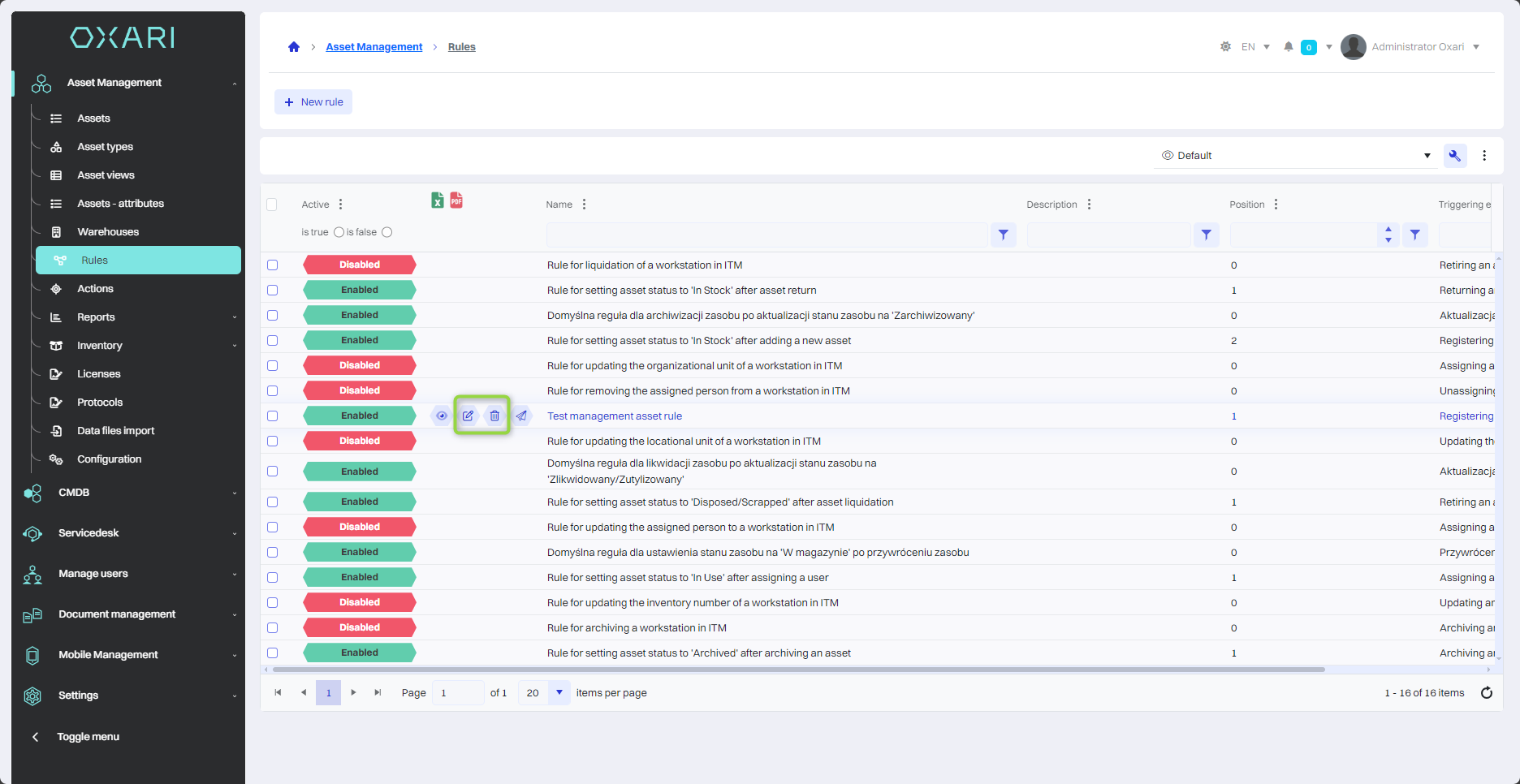
Activating/Deactivating a rule
Each rule can be activated or deactivated. To activate/deactivate a rule, go to Asset Management > Rules. Hover over the desired rule and click the edit button.
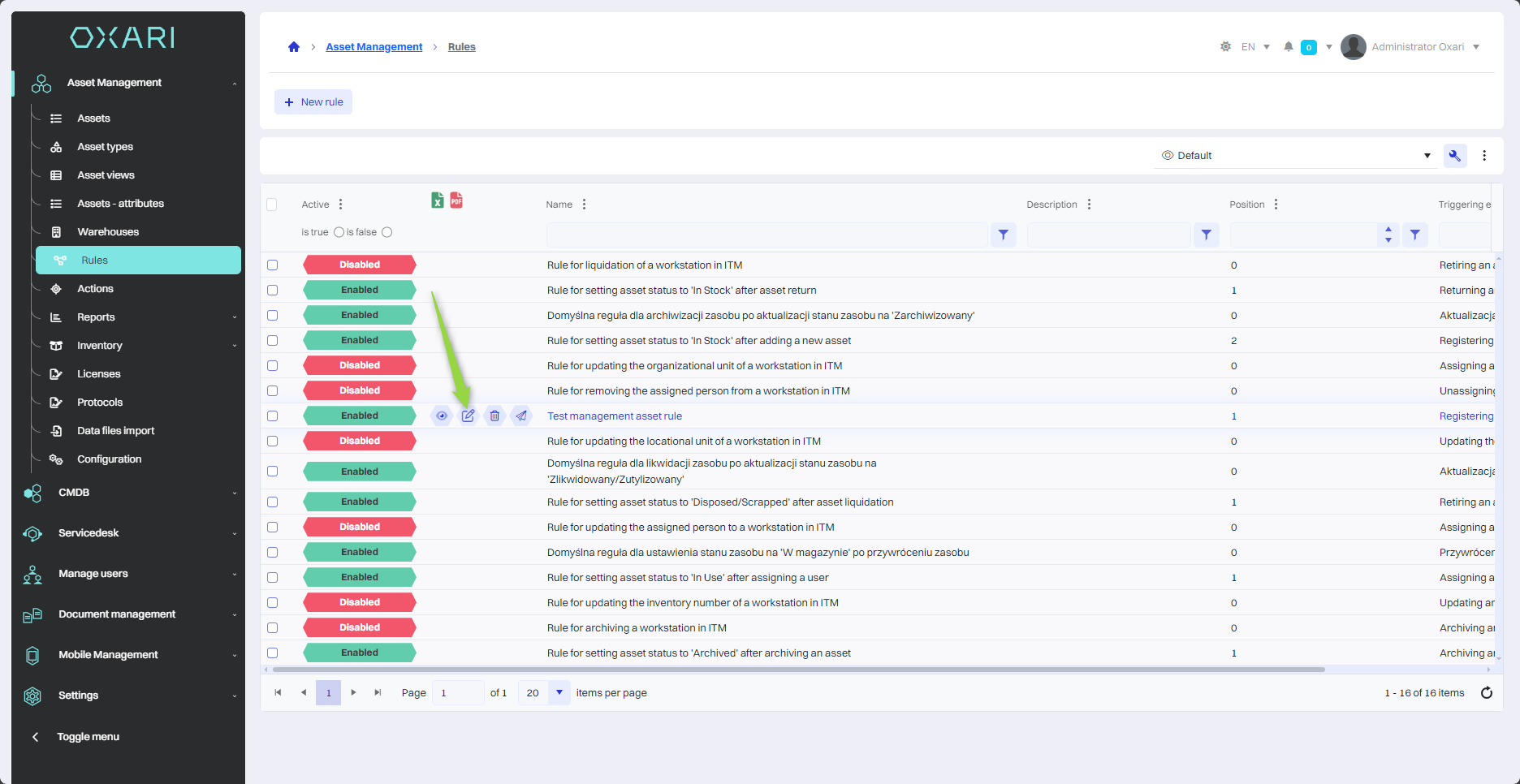
Then, in the edit window, click on the “Active” checkbox (a checked box means that the rule will be Active), finally click the “Save” button.
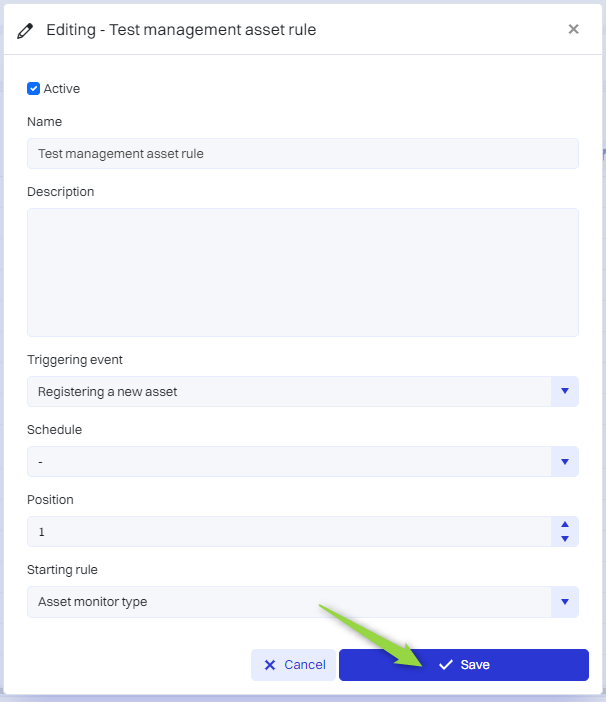
Testing a rule
To test rules, go to Asset Management > Rules. Hover over the desired rule. A button to perform the test is displayed.
Only rules with an assigned schedule can be tested.
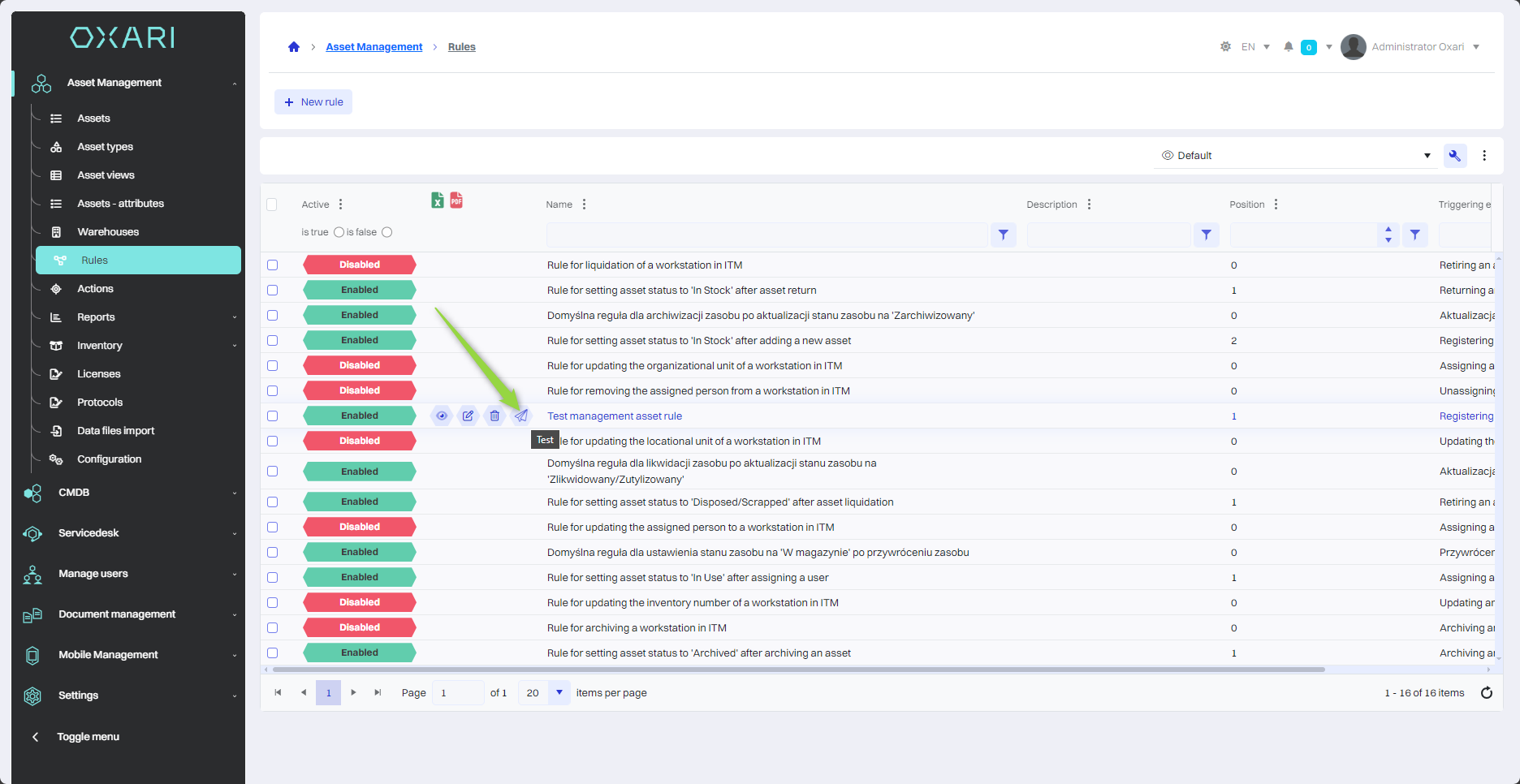
Description of trigger events
The table below provides a brief description of each trigger event:
| 1 | Registering a new asset - Adding a new asset to the Asset Management system. |
| 2 | Assigning a manager - Determining the person responsible for managing a asset. |
| 3 | Removing a asset - Removing a asset from the company's active assets. |
| 4 | Assigning a user - Assigning a asset to a specific company employee. |
| 5 | Return of a asset - Noting in the system the return of a asset by a user. |
| 6 | Removal of user assignment to a asset - Disconnecting the asset from the previously assigned user. |
| 7 | Assigning organizational structure to a asset - Linking a asset to a specific part of the organizational structure in the company. |
| 8 | Updating the location structure of a asset - Changing information about the location where the asset is stored. |
| 9 | Archiving the asset - Transferring the asset to the archive, that is, changing its status to inactive with the possibility of preserving historical data. |
